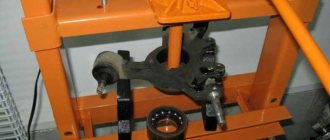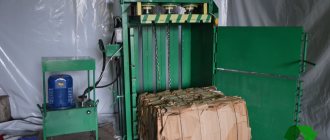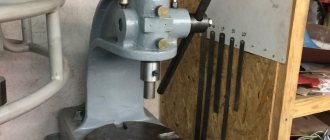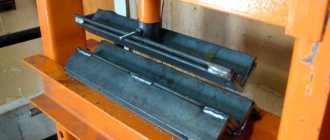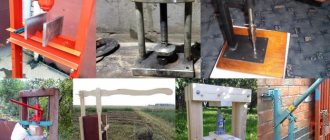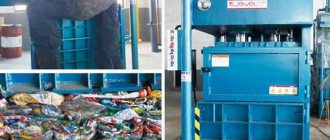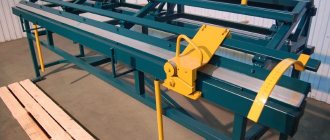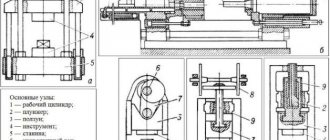For the full functioning of an automobile workshop or machine shop, it must be equipped with a manual hydraulic press. The use of such compact but effective equipment allows you to successfully and without unnecessary labor costs carry out many technological operations associated with the installation and dismantling of structural elements of various technical devices, as well as with adjusting and changing the shape of metal products.
Manual hydraulic presses are used in auto repair shops for a variety of operations.
Areas of application
Conventional hydraulic presses are not much different from portable ones intended for a car repair shop or garage, both in design and principle of operation. The main differences lie in the control systems of such devices, as well as in the range of functionality that they possess.
Using manual hydraulic presses, you can perform a certain list of technological operations, which is quite sufficient to solve the problems of repairing vehicles or any other technical devices. Depending on the size of manual pressing equipment, which directly affects its functionality, there are:
- hydraulic floor press;
- tabletop portable hydraulic press.
Devices of the first type are used for processing large parts, and a tabletop hydraulic press, characterized by compact dimensions, is used for processing small-sized products.
Pressing in the silent block using a manual hydraulic press
The most common technological operations performed using a manual hydraulic press are:
- installation and dismantling of shafts, elements of bearing units and bushings;
- stamping and calibration of metal parts;
- adjustment and change in the configuration of products made of metal.
It is not always possible to use conventional hydraulic presses for service stations or to equip a home workshop due to the rather large size of such devices. That is why the best option is to use a manual hydraulic press, which not only saves space, but often even reduces labor costs.
It should be borne in mind that the name “garage press,” which is often used in relation to manual pressing equipment, has a figurative meaning. A manual hydraulic press is a fairly universal piece of equipment that can be used not only to equip car service stations, but also in home workshops, repair shops or even garages.
What can a hydraulic pressing machine be made from?
The most popular device for making a hydraulic press is a jack, the actions of which are based on the operating principle of hydraulics. According to the laws of physics, the liquid in it under pressure does not reduce its volume. Therefore, when impacting the workpiece being processed, no loss of power is observed. In addition, the jack is characterized by high efficiency, thanks to which you can count on significant compression force.
To make a homemade device, you can use a diagram of a hydraulic press from a jack, which can be found on the Internet. At the first stage, a structural frame is created from a steel profiled pipe, metal corners and a plate. A jack is installed between the thrust plate and the platform, and it is necessary that when the rod is retracted, the tip of the rod is inside the latch. The base of the tool is attached to the movable stop using bolts.
To make a hydraulic press with your own hands, use a jack.
To crimp metal workpieces, the product is placed on a platform, the jack is raised when its lever is pressed. In this case, the pressing process occurs. It is important to know how to lower a hydraulic jack, which must be done after finishing the job. For this purpose, the tool is equipped with a bypass valve. It has a round head with protruding shoulders. It must be loosened, causing the device to lower.
The jack also has a shut-off valve that, when closed, pumps oil into the piston. Normal operation of the device indicates a sufficient amount of fluid in the system. If the tool starts to work slowly or stops completely, this means that there is little working fluid in it. You need to know how to fill a hydraulic jack with oil. To do this, there is a special filler plug on the device body, which must be unscrewed. Next, the tank is filled to the required volume. At the end of the procedure, the jack is pumped.
A manual hydraulic press is a multifunctional equipment that is widely used in car repair shops. This is an indispensable assistant for the home workshop. When choosing a device, it is important to determine the scope of its use. For domestic purposes, a device designed for a force of up to 20 tons is sufficient, but for a large service station a hydraulic press of 50 tons is needed. You can save money by making your own press from a jack.
Design features and classification
In terms of their design, manual hydraulic presses (“hydro” in translation from Greek means “water,” but in such equipment the role of the working fluid is played not only by pure water, but also by mineral oil, as well as an aqueous emulsion) are very similar to jacks, for the operation of which hydraulics are used.
Operating principle of the hydraulic part of the press
The main design elements of such devices are:
- a container that contains working fluid pumped into the hydraulic cylinder;
- discharge valve and shut-off valve, ensuring safe operation of the hydraulic press;
- a lever that activates a mechanism that supplies working fluid to the chamber of a hydraulic cylinder (the result is the movement of a piston, the rod of which creates the force exerted on the executive body of the equipment).
Main parts of manual hydraulic press
The use of a lever mechanism for pumping working fluid distinguishes a hydraulic floor or tabletop manual press from stationary equipment for similar purposes. A design feature of hydraulic presses for a car service center, home workshop or garage is also that the installation of the rod in a certain position relative to the workpiece is ensured by the user. This allows the use of a hydraulic press to perform technological operations on parts located in hard-to-reach places in the structure.
In the equipment under consideration, a manual lever-type hydraulic pump is most often used as a drive.
High-performance presses can be equipped with a foot drive
The pumping of working fluid into the hydraulic cylinders of most models of stationary hydraulic presses is carried out through the use of a special compressor or hydraulic pump. Unlike manual models, a stationary hydraulic press is capable of creating greater forces, which makes it more versatile in terms of functionality. When processed on a stationary hydraulic press, the workpiece is installed on a work table, the basis of which is two powerful channels.
A thrust plate or other devices can be additionally installed between them. Many models of hydraulic garage presses and press equipment for auto repair shops are also equipped with support platforms for installing workpieces. The location of such platforms relative to the hydraulic cylinder rod can be changed, which is provided by holes drilled in the vertical racks of the equipment at different heights.
Classification of manual hydraulic presses is carried out according to a number of parameters.
- Direction of movement of the working rod. According to this parameter, there are models of manual hydraulic presses, the rod of which can move up or down. In most modern models, the rod moves downward.
- The method by which a hydraulic floor or tabletop press is driven. As mentioned above, to operate such equipment, a hand pump is used, which in some models can be replaced with an electric hydraulic pump. With such a replacement, the productivity of the pressing equipment increases.
- Possibility of equipping the rod with various attachments. The use of additional attachments, provided in the design of many modern models of manual pressing equipment, significantly expands the functionality of such devices.
- Degree of equipment mobility. Floor-standing models, like a tabletop hydraulic press, can contain special wheels in their design, which significantly increases the mobility of such devices and allows them to be moved quickly and without much labor to the location of the structure or part that needs to be processed.
How does a hydraulic press work?
The principle of a hydraulic press is based on the law of communicating vessels. For example, there are 2 connected containers of different sizes. By pouring the liquid there, it will be evenly distributed. If the state of rest is disturbed and the pressure in the smaller vessel is increased, then in the larger vessel the applied force will increase in proportion to the difference in size. The device obeys the rule: the gain in strength is equal to the loss in distance.
Read also: Cylindrical grinding machine 3a423 technical characteristics
Blaise Pascal came up with the idea of how the hydraulic press works, but called it a “machine for increasing strength.” Previously, the benefits from such a machine seemed negligible, but now engineers used Pascal's developments to make the work easier.
Main characteristics
When purchasing a hydraulic floor or tabletop press, you should first decide on the tasks for which it is purchased (for a car service center or for home use in the garage). The required technical and operational characteristics of the equipment will depend on the nature and complexity of such tasks.
One of the main parameters that are considered when choosing manual pressing equipment is the design. So, depending on the tasks for which the device will be used, a hydraulic floor press or a tabletop model is selected. As a rule, large service stations for which car repair is the main activity are equipped with both floor-standing and table-top models, which allows such enterprises to increase the productivity of their technological operations, as well as to offer their customers a wider range of services.
Tabletop hydraulic press with movable piston
Among the characteristics that distinguish garage or auto service hand presses are:
- hydraulic cylinder characteristics;
- parameters of the structure on which such a hydraulic cylinder is installed.
The hydraulic press parameters contain a technical passport, which should be carefully studied when choosing equipment.
The main characteristics of the hydraulic cylinder equipped with a manual press include the following parameters:
- maximum force (if you rely on the technical data sheet, the value of this parameter varies in the range of 5–20 tons);
- the distance over which the rod can move, exerting force on the workpiece;
- type of mechanism by which working fluid is pumped into a hydraulic cylinder.
Manual hydraulic jack press
When choosing a desktop model of a manual hydraulic press, it is necessary to take into account the following characteristics of the equipment, which are also contained in its technical passport:
- dimensions and weight of the device;
- type and characteristics of the working platform: its dimensions, the presence of grooves in the design for mounting additional elements, the possibility of displacement along the press frame relative to its rod;
- the presence of shock-absorbing elements in the equipment of the table press, which are necessary in order to compensate for the excess pressure created on the structure of the device.
Adjustable trapezoid plates
Parameters that require attention are also the material of manufacture and the thickness of the base plate of the manual hydraulic press on which the parts are installed during processing.
Thus, focusing on the technical characteristics contained in the passport of a manual hydraulic press, you can find a model suitable for solving specific technical problems.
What is a hydraulic press: description of the device
The inventor of the hydraulic press is Joseph Brahm, who patented his discovery in 1795. Initially, the device was used for obtaining vegetable oil, squeezing juice from grapes and baling hay. Today, such a special installation is used for processing metal elements and workpieces; it is used to process plastic, plywood and rubber.
Initially, the hydraulic press was invented for squeezing grapes and producing vegetable oil.
The device is often used in auto repair shops for bending and compressing materials, pressing and unpressing bearings, when performing major repairs of gearboxes, suspensions, and vehicle power plants. When using the device, no significant effort is required.
The press consists of a frame with a bed, two hydraulic cylinders that differ in diameter, a hydraulic pump and a pressure gauge. Both cylinders are connected to each other. Each of them contains a special mineral oil. In appearance, the device resembles a jack that works according to the laws of hydraulics.
Note! The hydraulic press frame must be made of thick steel, which has a positive effect on the maximum load threshold value.
The force required to process workpieces is controlled by a pressure gauge. The presence of control and measuring equipment allows you to regulate the load force, which is necessary for a high-power tool.
Hydraulic presses are used for pressing in and out of bearings, repairing auto parts, as well as for bending and compressing materials.
The hydraulic press can be manual, pneumohydraulic or electrically driven. The manual device develops a force of up to 20 tons. It is mainly used in small workshops and garages. The pneumohydraulic product includes a hydraulic booster and a pneumatic cylinder. This hydraulic press develops a force of 40 tons. Models with electric drive are used in production. The maximum possible force for such hydraulic presses is 100 tons.
Recommendations for use
In order not to encounter a situation where a manual hydraulic press requires repair after a short period of use, certain rules should be followed. First of all, it is necessary to pay attention to the correct installation of the press, focusing on the information provided in the accompanying document by the manufacturer.
Recommendations for operating a manual hydraulic press, which will avoid its frequent breakdowns and, accordingly, the need for repairs, are as follows:
- checking the working fluid level (this affects how much pressure the hydraulic cylinder can create);
- regular lubrication of moving and rubbing parts;
- checking the condition of sealing elements, which may lose their elasticity over time;
- checking the reliability of fastening the part during its processing.
Typical faults and methods for their elimination
When moving a manual hydraulic press, it is necessary to monitor the level at which the work table is located. This parameter is checked every time the pressing equipment is started.
Operating principle of a hydraulic press
Next, let's look at how a hydraulic press works. The principle of operation is based on Pascal's law, which determines that pressure can be transmitted without change to any point in the liquid. When acting on the piston, force is transmitted through the working fluid of a vessel with a smaller diameter to a cylinder with a larger cross-section. This helps to increase the applied force as many times as the area of the piston of the larger vessel exceeds the area of the smaller hydraulic cylinder.
The pressure in cylinders of different cross-sections depends on the surface area of the piston and the applied force. If you apply a small force to a small cylinder, you will be able to obtain significant resistance from the larger vessel. For best results, the smaller piston must move a greater distance.
The operating principle of a manual hydraulic press is based on Pascal's law.
The operating principle of a hydraulic press can be compared to the operating principle of a mechanical lever. The force transmitted through his shoulder increases in proportion to the ratio of the lengths of the shoulders (large and small). In hydraulic devices, this lever is the liquid. The applied force will be increased in proportion to the areas of the working surfaces of the hydraulic cylinders.
Conclusion
A hydraulic press should be selected taking into account the needs of the repair/production site . Not in all cases a press with great effort is needed. An ordinary repair shop usually makes do with a 10 (tf) hydraulic press , which uses a simple lever pump.
For the production site you need to look for something more powerful and productive . The level of automation is important in production, so hydraulic presses of this class usually use an electro-hydraulic device.
